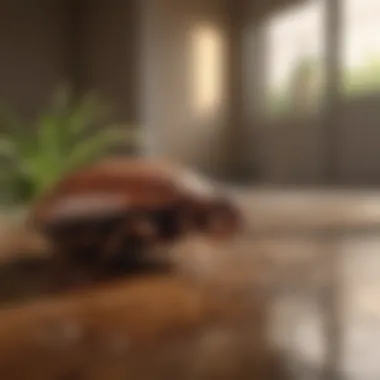Effective Pet-Safe Strategies for Roach Control


Intro
Cockroaches are pervasive insects that can infiltrate homes, especially in urban areas. They are not just unsightly; these pests can carry bacteria and trigger allergies. For pet owners, the presence of cockroaches introduces additional concerns regarding the health and safety of their animals. The challenge becomes finding effective ways to eliminate these pests without endangering pets. This article will explore strategies that prioritize both pest control and the well-being of pets. We will delve into natural remedies, prevention techniques, and when to enlist professional help for a thorough and safe eradication process.
Natural Remedies for Roach Control
Natural methods can be effective and safer for pets compared to chemical treatments. Homeowners have a variety of options at their disposal that utilize everyday ingredients.
Some common natural remedies include:
- Diatomaceous Earth: This powdery substance can be sprinkled in corners where cockroaches frequent. Its abrasive nature damages the exoskeleton of these insects, leading to dehydration.
- Boric Acid: Although it can be toxic in high doses, small amounts are often safe when used carefully. Mix it with sugar to attract roaches. Place this mixture in out-of-reach areas for pets.
- Essential Oils: Oils such as peppermint and tea tree have insect-repelling properties. Spraying a mixture containing these oils may deter roaches from entering your space.
Preventative Measures
Prevention plays an essential role in managing roach infestations. Homeowners can implement several changes to discourage cockroaches from taking up residence:
- Seal Cracks and Crevices: Inspect the home for gaps around doors, windows, and walls. Sealing these openings will reduce potential entry points for roaches.
- Maintain Cleanliness: A clean home is less attractive to pests. Wipe down surfaces frequently and avoid leaving food out.
- Proper Waste Disposal: Ensure that trash is disposed of regularly and containers are kept tightly sealed.
- Regular Inspections: Keep an eye out for any signs of infestation early. This might include droppings or the egg cases that roaches leave behind.
Consultation with Professionals
In more severe cases of infestation, consulting with pest control experts can be the best course of action. When selecting a professional, look for those who specialize in pet-friendly treatments. They can offer tailored solutions that comply with safety standards. It is beneficial to inform them about your pets upfront so they can plan accordingly.
Closure
Navigating the complexities of cockroach elimination while ensuring the safety of pets is indeed a challenge. The strategies discussed—natural remedies, preventive measures, and professional consultations—allow homeowners to combat roaches without compromising their pets' health. By integrating these methods into daily routines, you can maintain a harmonious living environment free from unwelcome pests.
Intro to the Roach Problem
Roaches are a significant problem in many urban areas. Their presence can lead to health concerns, including allergies and asthma, especially in vulnerable populations like children and pets. Therefore, understanding the roach problem is essential for homeowners looking to maintain a safe and healthy living environment. This section helps to outline the complexities surrounding roach infestations.
Understanding Cockroach Behavior
Cockroaches are resilient insects. They can survive in various conditions, making them difficult to eliminate. They are nocturnal and tend to hide in dark places during the day, which complicates detection. They are attracted to food, moisture, and warmth. Their breeding cycle is rapid, with a single female capable of producing hundreds of offspring in her lifetime. This reproductive ability exacerbates the infestation issue. To effectively manage this problem, one must understand their preferences and behaviors.
Many homeowners underestimate the persistence of cockroaches. They can adapt to numerous environments, making traditional pest control methods less effective over time. Developing a strategy to manage these pests requires a keen understanding of their habits and habitats.
Why Traditional Methods May Not Work
Common pest control methods often rely on toxic chemicals. While these may be effective in killing roaches, they can also harm pets and humans if not used carefully. Many sprays and baits are not designed with pet safety in mind. As a result, families with pets may find traditional extermination techniques unsuitable.
Additionally, chemicals can create a false sense of security. Homeowners might see a temporary reduction in roach activity, but without addressing the underlying behavior and habitat, roaches tend to return. Thus, focusing solely on chemical solutions can lead to recurrent infestations, creating ongoing challenges.
"Understanding cockroach behavior is critical in developing more effective and safer elimination strategies."
The reality of the roach problem is that it requires a comprehensive evaluation of both behavior and methods. A successful strategy is to embrace an integrated approach combining preventive measures, natural remedies, and, when necessary, professional help. Each of these components plays a role in maintaining a safe and roach-free home.
Evaluating the Safety of Common Treatments
Evaluating the safety of treatments in pest management is crucial, particularly when there are pets in the household. Roaches not only disrupt daily life but can also carry health risks. Hence, the methods used to eliminate them should be effective yet not harmful to furry family members. Understanding the safety of common treatments helps homeowners make informed decisions and minimize unnecessary hazards.
Overview of Toxic vs. Non-toxic Solutions
In the realm of roach elimination, there are two main types of solutions: toxic and non-toxic. Toxic solutions often include pesticides that contain active ingredients which can be harmful to both humans and pets. While these may promise quick results, the potential side effects should not be overlooked. Such substances can linger in the environment, posing ongoing risks.


Non-toxic solutions, on the other hand, employ natural ingredients. These might include essential oils, diatomaceous earth, and homemade traps. Though they may take longer to show results, they offer a safer alternative that aligns with pet safety priorities. Choosing non-toxic methods often means a more favorable environment for pets.
When assessing these solutions, consider the following:
- Efficacy: How well does the treatment work?
- Duration of Action: How long does it remain effective?
- Environmental Impact: What are the implications for air quality and residues?
In general, non-toxic solutions may require regular application and a consistent strategy. Homeowners should temper expectations and readiness to adapt as necessary.
Assessing Risks to Pets
Pet safety hinges on the whims of many factors, including the type of treatment used and the circumstances under which it’s employed. When opting for any roach control method, it’s essential to assess how it might interact with pets. Here are several risks to consider:
- Ingestion: Pets are often curious. They may consume bait or treated materials, leading to poisoning.
- Contact Exposure: Pesticides can remain on surfaces; pets touching treated areas may absorb harmful substances.
- Respiratory Risks: Aerosol sprays can affect indoor air quality, which is particularly hazardous for pets with pre-existing conditions.
Homeowners should always read labels and understand the implications of applying these products in the presence of pets. In some instances, it could be beneficial to designate areas off-limits during and after treatment applications. This practice helps reduce exposure significantly and promotes a worry-free environment.
"Always prioritize non-toxic treatments when pets are involved to ensure their health and safety while addressing pest issues."
In summary, evaluating the safety of common treatments involves a thorough understanding of the balance between efficacy and pet well-being. This knowledge equips homeowners to choose wisely and mitigate risks in their quest for a roach-free environment.
Prevention as a First Line of Defense
Preventing a cockroach infestation is essential for maintaining a healthy home environment, especially when pets are involved. The first line of defense is not the elimination of roaches but rather preventing their entry and establishment in your living space. By addressing key factors that attract these pests and by making it difficult for them to thrive, homeowners can significantly reduce the chances of an infestation.
Effective prevention strategies take into account not just the health risks posed by cockroaches, but also the safety of pets. Pets are curious creatures; they explore their environments and, at times, ingest substances they shouldn’t. Thus, implementing prevention techniques minimizes the risk for both owners and their pets. Here are three key components that contribute to a solid preventive strategy:
Proper Waste Management Practices
Proper waste management is one of the most crucial aspects of keeping cockroaches at bay. Roaches are opportunistic feeders and are attracted to food waste. To minimize this risk:
- Use sealed containers: Store food in airtight containers to limit access for pests.
- Dispose of garbage regularly: Remove trash at least once a week, and ensure that bins have tight-fitting lids.
- Clean up spills immediately: Be proactive in cleaning up food and drink spills to avoid attracting pests.
These practices help deny roaches their primary resource—food—which is vital for breaking the cycle of infestation.
Sealing Off Entry Points
Another effective prevention method is thoroughly inspecting your home to seal off entry points. Cockroaches can enter through very small gaps and cracks; thus, ensuring these are sealed is essential. Homeowners should focus on the following areas:
- Windows and doors: Check for gaps and install weather stripping or door sweeps to prevent access.
- Pipes and vents: Fill any cracks around plumbing and electrical lines with caulking.
- Foundations: Inspect the foundation for cracks and repair them as needed.
Addressing these potential entry points will make your home less inviting and significantly reduce the chances of a roach problem.
Maintaining Clean Spaces
Maintaining a clean environment is yet another fundamental method of preventing cockroaches. A tidy living space not only deters roaches but also promotes overall health and hygiene. Homeowners should prioritize:
- Regular cleaning: Vacuum and mop floors frequently to eliminate crumbs and debris where roaches might feed.
- Decluttering: Keep living spaces clear of clutter, as it provides hiding spots for pests.
- Pet areas: Clean pet feeding areas daily and wash bowls regularly to minimize food availability.
By creating an inhospitable environment for roaches, the likelihood of their presence decreases significantly.
"An ounce of prevention is worth a pound of cure." This adage rings true when it comes to pest management. By implementing these preventive measures, homeowners can avoid the complex and costly process of dealing with a full-blown roach infestation.
Natural Remedies for Roach Control


Natural remedies play a significant role in roach control, especially for households with pets. By utilizing non-toxic options, pet owners can address infestations without jeopardizing the well-being of their animals. This section will explore key natural solutions, their effectiveness, and considerations for their use in homes.
Essential Oils and Their Efficacy
Essential oils are known for their various properties, including insect-repelling capabilities. Oils such as peppermint, eucalyptus, and tea tree have shown efficacy against cockroaches. Their potent scent disrupts the roaches' communication and navigation systems, making it harder for them to find food and mates.
Using essential oils is simple. A few drops can be mixed with water in a spray bottle and applied in areas where roaches are likely to roam. However, it's vital to consider the concentration. High concentrations can cause irritation to pets. Therefore, a diluted blend is advisable. Regular application is key since the effects tend to wear off. You can refresh the spray bi-weekly or after heavy cleaning in the treated areas.
Homemade Traps Using Simple Ingredients
Creating homemade traps provides a practical way to catch cockroaches without using harmful chemicals. One effective trap is composed of a mixture of sugar and baking soda. Sugar attracts the roaches, while baking soda is lethal when ingested. Here is a basic approach:
- Ingredients Needed:
- Instructions:
- 1 part sugar
- 1 part baking soda
- Mix the sugar and baking soda in equal portions.
- Place the mixture in small containers or on shallow lids in areas frequented by roaches.
- Check and replace the mixture as required.
This method is straightforward and leverages ingredients easily found in most kitchens. It is also safe for pets when placed out of their reach. Additional traps can be made using vinegar and water in a bowl, where roaches drown after being attracted by the smell.
Utilizing Diatomaceous Earth
Diatomaceous earth (DE) is a natural powder made from fossilized algae. It serves as an excellent deterrent against cockroaches. The abrasive nature of DE disrupts the exoskeleton of insects, leading to dehydration and death.
When using diatomaceous earth, it is important to choose food-grade quality to ensure safety for household pets. Application involves lightly sprinkling the powder in areas where roaches hide or travel, such as along baseboards and under furniture. Here are some key points for effective use:
- Keep It Dry: DE works best when dry, as moisture reduces its efficacy.
- Regular Reapplication: Reapply after cleaning or if it becomes damp.
- Monitor Pet Activity: Ensure pets do not ingest the powder. Place it in locations that are less accessible to them.
Using diatomaceous earth is a sustainable option, and it provides a continuous barrier that deters roaches effectively.
In summary, utilizing natural remedies for roach control is both a proactive and responsible approach for pet owners. Solutions like essential oils, homemade traps, and diatomaceous earth can effectively combat infestations without harming pets.
By incorporating these strategies, homeowners can create a safer living environment while addressing cockroach issues.
Commercial Solutions That Ensure Pet Safety
When dealing with a roach problem, the solution should not only be effective but also safe for pets. The importance of selecting commercial solutions tailored for pet safety cannot be overstated. Traditional roach extermination methods often utilize harsh chemicals, which can harm pets if inhaled or ingested. Thus, it is essential to explore options that combine efficacy with a commitment to animal safety.
Commercial solutions come with their own set of benefits. Many companies now offer products that target specific elimination without compromising the health of household animals. These solutions are generally formulated with safer ingredients or come in application methods that minimize exposure. Homeowners should consider these products an integral part of their pest management strategy for both practical and ethical reasons.
Identifying Trusted Brands
Identifying trusted brands is critical in navigating the commercial pest control market. Many products are marketed as being pet-safe, but the reliability of these claims can vary significantly. Homeowners should look for brands with a strong reputation in pest control. Brands like Orkin, Terminix, and Hot Shot have established themselves in the industry and consistently receive positive reviews for their pet-safe options.
Before making a purchase, consumers should also:
- Research Ingredients: Check the label for non-toxic or naturally derived ingredients. Look for certifications that validate safety claims.
- Read Reviews: Customer feedback can provide insight into the effectiveness and safety of a product. Forums like Reddit can also be a good resource for shared experiences.
- Seek Recommendations: Consulting professionals or trusted friends who have previously tackled similar issues can guide product selection.
Guidelines for Safe Application
The safety of pets during roach elimination extends beyond the choice of products; it also involves how these products are used. Following guidelines for safe application is necessary. Here are some key practices:
- Read Instructions Thoroughly: Each product comes with specific guidelines on usage and safety measures. Following them can mitigate risks.
- Restrict Access: Before applying any pest control solution, ensure pets are kept away from the treatment area. This reduces the likelihood of accidental ingestion or contact.
- Ventilate the Area: Open windows and doors while applying treatments to ensure good air circulation. This can help dissipate chemical odors quickly.
- Timing of Application: If possible, apply pest control solutions when pets are away from home, such as during a visit to the park or a friend’s house.
- Monitor Pets Post-Application: After returning home, observe your pets for any unusual behaviors or reactions. If there are concerns, consult your veterinarian.


By following these guidelines, homeowners can effectively manage roach infestations while keeping their pets safe.
Consider pet safety as integral to pest control strategies. In the long run, blending good practices with reliable products will yield the best outcomes for both your home and your pets.
When to Consult Professionals
Engaging a professional pest control service can sometimes feel like a last resort, yet it is an important consideration when dealing with a cockroach infestation. For many homeowners, the sight of a roach is alarming and prompts immediate action. This instinct leads many to attempt DIY methods that may not be sufficient. Recognizing when to call in experts can save time and prevent further pest-related complications. The safety of pets is equally vital in such cases, necessitating careful thought on choosing appropriate solutions.
Signs That DIY Efforts Are Insufficient
There are several indicators that suggest a more serious infestation requiring professional intervention. Consider the following signs:
- Persistent sightings: If you consistently notice cockroaches, especially during the day, it may indicate a significant problem that goes beyond simple cleaning or traps.
- Failed remedies: When popular DIY solutions, such as bait or essential oils, do not produce the expected results, it may signal a deeper issue in your home.
- Presence of droppings: The discovery of cockroach droppings, which resemble small black specks, can indicate high levels of infestation that warrants a professional approach.
- Egg cases: Spotting cockroach egg casings (ootheca) is a clear sign of an ongoing reproductive cycle that needs tackling.
- Allergies or health concerns: If household members or pets begin to show signs of allergies or respiratory issues that could relate to pest presence, it’s essential to act quickly.
Being observant about these elements can aid in decision-making regarding pest control. Ignoring these signs can lead to increasing health risks for both humans and pets.
Choosing a Pet-Friendly Pest Control Service
When feeling overwhelmed and opting for professional help, it's crucial to select a pest control service that prioritizes both effectiveness and safety. Here are some considerations to keep in mind:
- Research certifications: Look for services with appropriate licenses and certifications that indicate their expertise in pest management.
- Inquire about methods used: Ask the provider about their approach to eliminating roaches and ensure they use pet-safe products. This will help avoid harmful chemicals that may affect your furry friends.
- Check reviews and references: Research customer testimonials to gauge satisfaction levels and the effectiveness of services provided. Online platforms such as Reddit or Facebook can be useful for finding trustworthy recommendations.
- Get a detailed plan: A good company should offer a comprehensive plan, outlining strategies for elimination, as well as steps for prevention and follow-up monitoring.
- Follow-up services: Ensure that the service provides follow-up visits. Cockroach management is not a one-time task, and ongoing support is critical to preventing re-infestation.
Engaging a professional pest control service can be a significant investment. Doing your due diligence ensures that you find a service that respects your concerns about safety while delivering results.
Long-term Monitoring and Maintenance
Long-term monitoring and maintenance are essential components in the battle against roaches, especially in households with pets. These actions not only reinforce efforts made to eliminate pests but also help ensure that your living environment remains safe for furry companions. Without proper monitoring, even the most effective methods of roach control can become temporary solutions, leaving the door open for reinfestation. Regular inspections coupled with continuous education on pest management strategies play a major role in this equation.
Regular Inspections for Reinfestation
The key to effective pest management lies in early detection. Regular inspections can help identify signs of reinfestation before a small problem evolves into a major one. Here are several strategies to consider when setting up a regular inspection routine:
- Set a Schedule: Organize inspections at least once a month, paying particular attention to high-risk areas, such as kitchens and bathrooms. Consistency is crucial.
- Look for Signs: Be aware of indicators of roach activity, including droppings, egg cases, and shed skins. Take note of any unusual smells, as this can also signify an infestation.
- Check Common Hiding Places: Roaches like dark and damp spaces. Regularly inspect behind appliances, inside cabinets, and under sinks to assess whether these areas require further attention.
"A proactive approach to inspections not only maintains your pet’s environment but also safeguards your peace of mind."
Continued Education on Pest Management
Education is another pillar of long-term successful pest control. Remaining informed about new pest control methods and preventive measures empowers homeowners. Some points to consider include:
- Stay Updated on Products: Learn about new pet-friendly products emerging in the market. The pest control industry is forever evolving, offering effective solutions that pose minimal risk to pets.
- Join Local Forums: Engage with communities on platforms like Reddit or Facebook. These forums often have practical insights from homeowners who have faced similar challenges.
- Consult Experts Periodically: As pest management techniques change, so do the pests themselves. Periodic consultations with pest control professionals provide valuable tips tailored to your specific environment.
Through sustainable education, not only do you maintain your space, but you also foster a community that prioritizes pet safety while eschewing harmful pest control methods.
Epilogue: A Takeaway on Roach Management
Roach management is not merely about eliminating pests. It involves understanding behaviors, assessing risks, and implementing strategies that prioritize the safety of pets and humans alike. This article has provided a comprehensive overview of effective tactics, highlighting how to approach cockroach infestations in a thoughtful manner.
The importance of choosing methods that do not harm pets cannot be overstated. Many common pesticides can be dangerous to animals, so exploring pet-safe alternatives is vital for responsible home maintenance.
Key takeaways include:
- Prioritizing prevention through proper waste management, sealing entry points, and maintaining cleanliness. These proactive steps create an environment less hospitable to roaches.
- Adopting natural remedies, such as diatomaceous earth and essential oils, can effectively repel and control roach populations without risking pet safety.
- Understanding when to rely on professional services ensures that more significant infestations are handled correctly. Choosing pet-friendly pest control options can ease concerns about toxic exposure.
A multifaceted approach is necessary for successful roach management. By integrating knowledge of roach behavior with effective techniques, homeowners can achieve a balance between combating pests and maintaining safety.
"Integrating pet safety into pest management practices not only protects pets but also contributes to a healthier living environment for everyone in the household."
In summary, the commitment to a pet-safe approach to roach elimination is a pivotal element for any pet-owning homeowner. Continual education on pest management and regular inspections are essential for long-term success in this endeavor. Each action taken in a pet-friendly manner cumulatively leads to a safer and more pleasant home.















